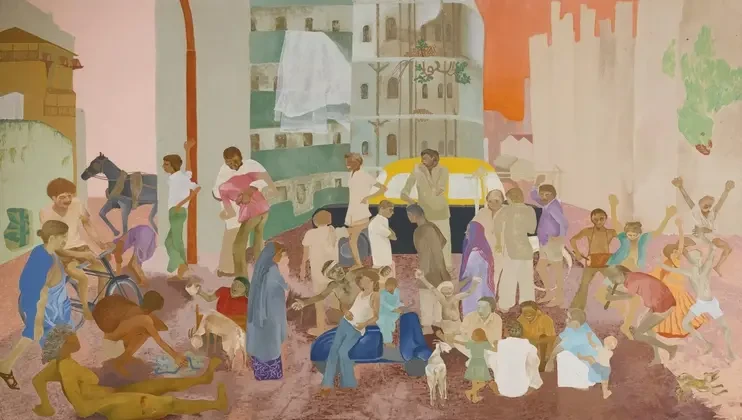The Imaginary Institution of India: Art 1975-1998
First major survey of pioneering Indian art 1975-1998
This entry has expired.

From 5 October 2024, the Barbican presents The Imaginary Institution of India: Art 1975-1998, the world’s first exhibition to explore and chart this period of significant cultural and political change in India. Featuring nearly 150 works of art across painting, sculpture, photography, installation and film, this landmark group show examines the ways in which 30 artists have distilled significant episodes of the late 20th century and reflected intimate moments of life during this time. A specially curated film season, Rewriting the Rules: Pioneering Indian Cinema after 1970, will run alongside the exhibition.
The declaration of the State of Emergency by Indira Gandhi in 1975 and the Pokhran Nuclear Tests in 1998 serve as bookends for a time when artists combined social observation with individual expression and innovation. They addressed issues relating to gender and sexuality, communal politics, urbanisation and changing class structures, and engaged with indigenous and vernacular modes of expression. Spanning painting, sculpture, photography, installation, and film, the exhibition will offer a unique view of this shifting socio-political landscape while exploring key practices within Indian art during the late 20th century.
Works on display include:
- Gulammohammed Sheikh’s painting Speechless City which draws on different art historical painting traditions to respond to the oppressive political atmosphere of the 1975-77 State of Emergency.
- Gieve Patel’s empathetic paintings which vividly portray daily life in the streets of India’s rapidly expanding, cosmopolitan cities in the 1980s.
- Sunil Gupta’s photographic series Exiles, from 1987, which makes visible the lives of gay men in New Delhi in and around some of its most recognisable landmarks.
- Sheba Chhachhi’s Seven Lives and a Dream, a series of photographs which juxtaposes moving and ferocious documentation of feminist grassroots campaigns in India with tenderly staged portraits of the women at their forefront.
- Meera Mukherjee’s intimately scaled and intricately detailed bronzes which, inspired by her time spent studying metal crafting traditions across India, use lost-wax casting techniques to address subjects both sacred and everyday.
- Savi Sawarkar’s bold etchings which deal with issues surrounding caste and untouchability.
- Rummana Hussain’s floor-based works which use broken terracotta pots to reckon with widespread communal violence across the nation following the demolition of the Babri Masjid in Ayodhya in 1992 by a militant right-wing Hindu mob.
- Installation works made from cow dung, thread, and sacred kumkum pigment by Sheela Gowda which make use of materials used as fuel, in religious rituals, and part of the everyday economy of women in rural places to interrogate the value of labour.
- A video installation by Nalini Malani in which moving image, projected on the walls and playing on monitors in tin trunks, considers the impact of India’s nuclear testing and links it to concerns around violence and forced displacement.
- Bhupen Khakhar’s exceptional paintings which tenderly evoke queer love and desire.
Participating artists include Pablo Bartholomew, Jyoti Bhatt, Rameshwar Broota, Sheba Chhachhi, Anita Dube, Sheela Gowda, Sunil Gupta, Safdar Hashmi, M. F. Husain, Rummana Hussain, Jitish Kallat, Bhupen Khakhar, K. P. Krishnakumar, Nalini Malani, Tyeb Mehta, Meera Mukherjee, Madhvi Parekh, Navjot Altaf, Gieve Patel, Sudhir Patwardhan, C. K. Rajan, N. N. Rimzon, Savindra Sawarkar, Himmat Shah, Gulammohammed Sheikh, Nilima Sheikh, Arpita Singh, Jangarh Singh Shyam, Vivan Sundaram, and J. Swaminathan.
Accompanying the exhibition, the Barbican will present Rewriting the Rules: Pioneering Indian Cinema after 1970 (3 Oct-12 Dec) curated by Dr Omar Ahmed, writer and international curator of South Asian Cinema. This season of documentary and narrative films from the 1970s, 80s and 90s considers the emergence of the new Parallel Cinema – one of South Asia’s first post-colonial film movements.
Further information:Welcome to the Barbican | Barbican
Venue details
- Address:
- Barbican Centre
- Silk Street
- London
- EC2Y 8DS